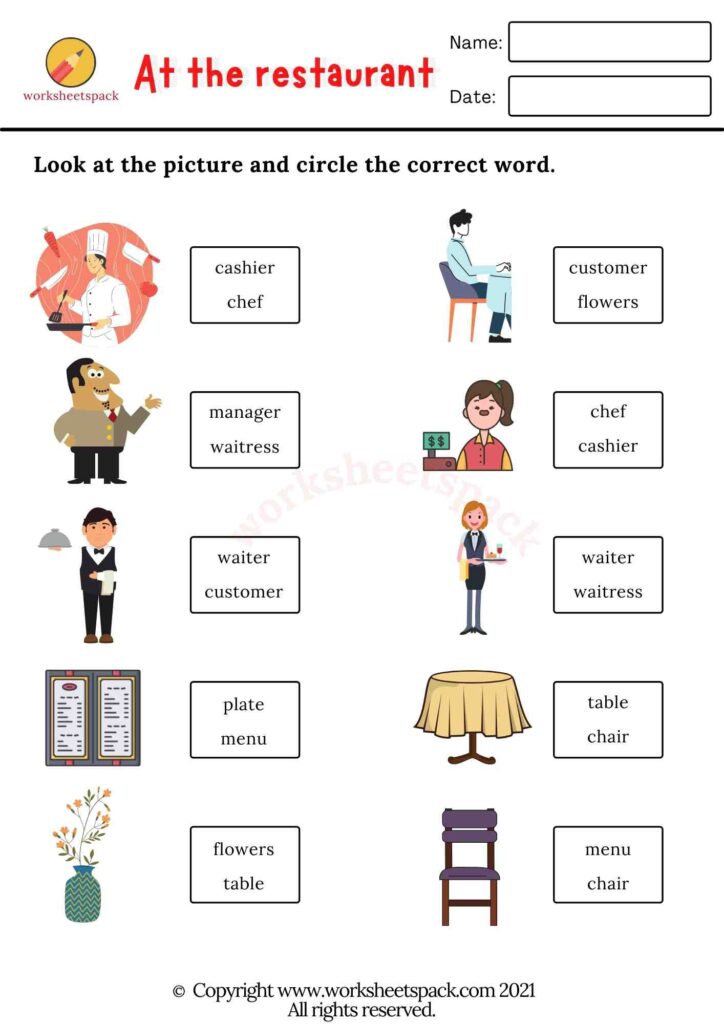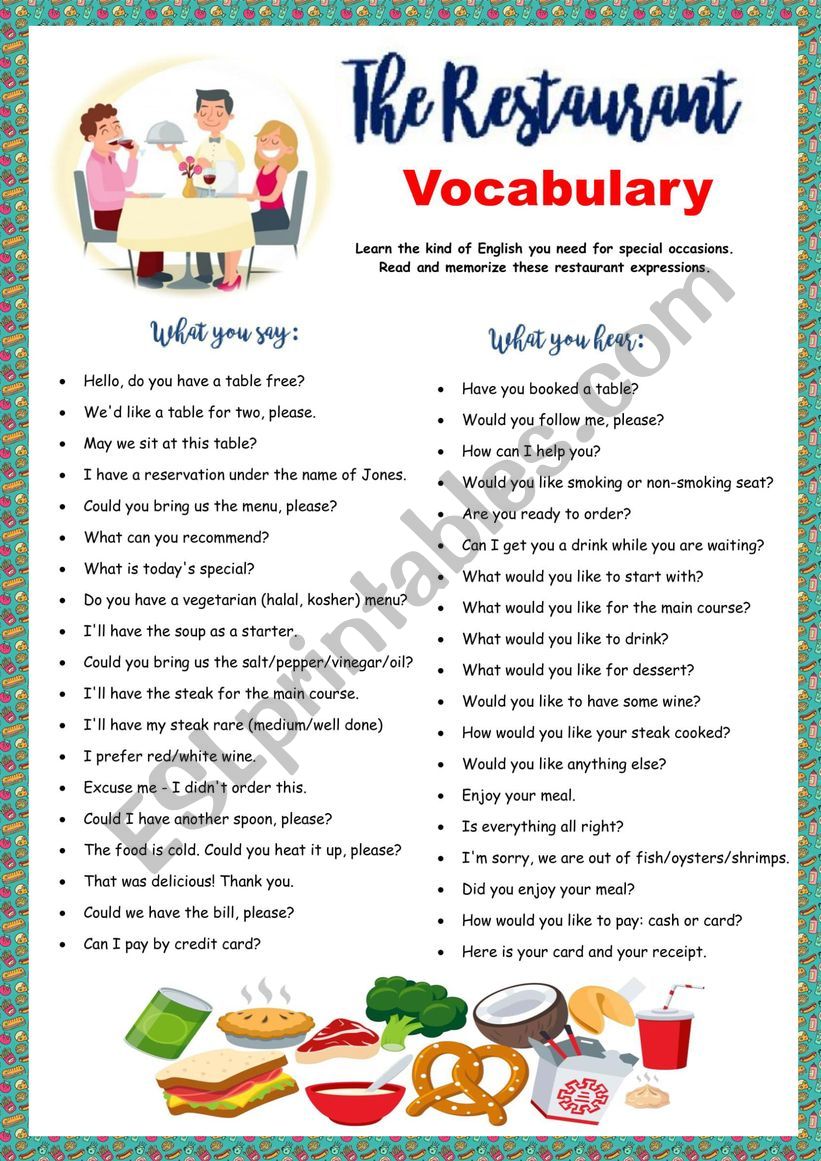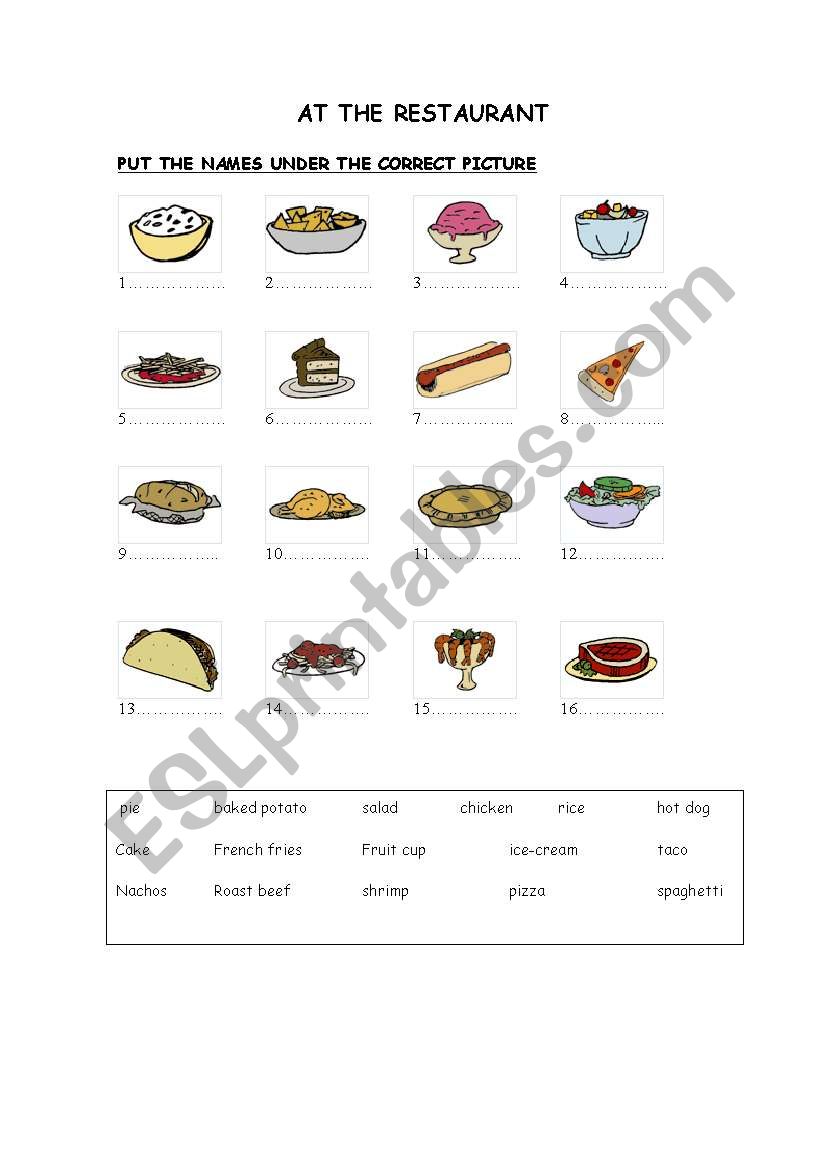
Mastering the Culinary Lexicon: The Indispensable Role of Restaurant Vocabulary Worksheets
In an increasingly globalized world, the ability to communicate effectively in English is a coveted skill across numerous industries. Among these, the hospitality sector, particularly the restaurant business, stands out as a domain where precise and nuanced language is not just an advantage, but a necessity. From taking orders and describing dishes to resolving complaints and engaging in casual dining conversations, a robust vocabulary is the cornerstone of successful interaction. This is where restaurant vocabulary worksheets emerge as an indispensable tool, serving as a structured, engaging, and highly effective method for acquiring the specific lexicon required to thrive in culinary environments.
This article delves deep into the significance of these worksheets, exploring their multifaceted benefits, the types of vocabulary they encompass, various activity formats, and how they can be effectively designed and integrated into language learning curricula.
The "Why": Unpacking the Importance of Dedicated Restaurant Vocabulary Learning

The language of a restaurant is a unique blend of general English, industry-specific jargon, and cultural nuances. Merely knowing common English words isn’t enough to confidently navigate a busy dining room or a professional kitchen. Here’s why dedicated learning through tools like restaurant vocabulary worksheets is crucial:

- Precision and Clarity: In a fast-paced environment, miscommunication can lead to incorrect orders, dissatisfied customers, or even safety hazards. Understanding specific terms for ingredients, cooking methods, dietary restrictions, and service actions ensures clarity.
- Professionalism and Confidence: Staff who can articulate themselves clearly and confidently, using appropriate terminology, project an image of professionalism. For diners, understanding the menu and being able to communicate their needs enhances their experience and confidence.
- Enhanced Customer Service: The ability to explain a dish, recommend a wine, or politely handle a complaint relies heavily on a specialized vocabulary. Good communication directly translates to better customer satisfaction and repeat business.
- Career Advancement: For individuals aspiring to work in the hospitality industry, a strong command of restaurant-specific English is a significant asset. It opens doors to better job opportunities and career progression, from entry-level positions to management roles.
- Cultural Immersion: Food is a cornerstone of culture. Learning restaurant vocabulary often involves understanding cultural dining practices, etiquette, and regional culinary terms, enriching the overall language learning experience.
- Accessibility for All: Whether you’re an ESL student aiming for a hospitality career, a tourist wanting to order confidently abroad, or a culinary enthusiast keen to understand food blogs and shows, these worksheets provide targeted learning.




Who Benefits Most from Restaurant Vocabulary Worksheets?
While anyone with an interest in food and language can benefit, certain groups find restaurant vocabulary worksheets particularly invaluable:

- ESL/EFL Learners: Non-native English speakers looking to improve their practical English for everyday life or specific purposes.
- Hospitality Management Students: Those pursuing degrees or certifications in culinary arts, hotel management, or tourism, who need to master industry-specific language.
- Job Seekers in the Restaurant Industry: Individuals preparing for interviews or starting new roles as waiters, chefs, hosts, bartenders, or kitchen staff.
- Travelers and Tourists: People visiting English-speaking countries who wish to order food, make reservations, or discuss their dining experiences confidently.
- Food Bloggers and Culinary Enthusiasts: Those who want to articulate their passion for food with precise terminology, whether writing reviews, discussing recipes, or engaging in food-related forums.
- Corporate Training Programs: Companies in the hospitality sector often use these materials for onboarding and continuous professional development of their staff.


Key Categories of Restaurant Vocabulary
Effective restaurant vocabulary worksheets break down the vast lexicon into manageable, thematic categories. Here are some of the most common and crucial areas:
-
The Menu & Food Items:
- Dishes: Appetizers, main courses, desserts, sides, specials, daily soup.
- Ingredients: Common meats, vegetables, fruits, grains, dairy, spices.
- Cooking Methods: Baked, fried, grilled, roasted, sautéed, boiled, braised, simmered.
- Dietary Terms: Vegetarian, vegan, gluten-free, dairy-free, nut allergy, kosher, halal.
- Flavor Profiles: Sweet, sour, salty, bitter, umami, spicy, savory, rich, tangy.
-
Restaurant Staff & Roles:
- Waiter/Waitress (Server), Host/Hostess, Chef (Head Chef, Sous Chef, Pastry Chef), Bartender, Sommelier, Busser, Dishwasher, Manager.
-
The Dining Experience (Customer Perspective):
- Making a reservation, being seated, ordering, asking for recommendations, requesting changes, asking for the check/bill, paying, leaving a tip, giving feedback, making a complaint.
-
Restaurant Operations (Staff Perspective):
- Taking orders, serving, clearing tables, setting tables, seating guests, upselling, taking payments, handling complaints, opening/closing duties.
-
Kitchen Vocabulary:
- Equipment: Oven, stove, microwave, blender, mixer, refrigerator, freezer, fryer, grill.
- Utensils: Knife, fork, spoon, plate, bowl, glass, cup, napkin, cutting board, spatula, whisk, tongs.
- Actions: Chop, slice, dice, mince, peel, grate, mix, stir, knead, season.
-
Adjectives for Describing Food:
- Delicious, tasty, flavorful, bland, tender, tough, juicy, dry, fresh, stale, crispy, soggy, aromatic.
Types of Restaurant Vocabulary Worksheets and Activities
The beauty of restaurant vocabulary worksheets lies in their versatility. They can be adapted into numerous formats to cater to different learning styles and skill levels:
-
Matching Exercises:
- Match words to their definitions.
- Match words to corresponding pictures (e.g., different types of cutlery, cooking methods).
- Match English terms to their equivalents in the learner’s native language.
-
Fill-in-the-Blank Sentences:
- Contextual sentences where learners choose the correct vocabulary word to complete the meaning (e.g., "The chef decided to __ the chicken before putting it in the oven.").
-
Role-Playing Scenarios:
- Perhaps the most effective for practical application. Worksheets can provide dialogue prompts for scenarios like:
- Customer ordering from a waiter.
- Waiter explaining daily specials.
- Customer making a reservation.
- Staff handling a customer complaint.
- These encourage active use of vocabulary in a simulated real-world context.
- Perhaps the most effective for practical application. Worksheets can provide dialogue prompts for scenarios like:
-
Picture Labeling:
- Worksheets with diagrams of a restaurant layout, kitchen equipment, or specific dishes, requiring learners to label each item.
-
Crosswords and Word Searches:
- Fun and engaging ways to reinforce vocabulary. Clues can be definitions or contextual sentences.
-
True/False Statements:
- Statements about restaurant operations or food descriptions that learners must evaluate for accuracy, prompting deeper understanding.
-
Sentence Construction/Sentence Completion:
- Providing a list of vocabulary words and asking learners to use each word in a grammatically correct and meaningful sentence related to a restaurant setting.
-
Categorization Activities:
- Providing a jumbled list of words and asking learners to sort them into categories (e.g., "Staff," "Dishes," "Kitchen Utensils").
-
Menu Analysis:
- Presenting an actual or simulated restaurant menu and asking learners to identify specific types of dishes, ingredients, or to answer questions based on the menu.
-
Dictation Exercises:
- Reading out a short dialogue or description related to a restaurant, and learners write down the vocabulary words they hear.
Designing Effective Restaurant Vocabulary Worksheets
For educators, creating impactful restaurant vocabulary worksheets involves several considerations:
- Authenticity: Use real-world examples whenever possible – actual menu excerpts, common dialogue phrases, or realistic scenarios.
- Contextualization: Don’t just present lists of words. Embed vocabulary in sentences, dialogues, or descriptions that illustrate their usage.
- Variety: Mix different activity types within a single worksheet or across a series of worksheets to maintain engagement and cater to diverse learning styles.
- Scaffolding: Start with basic, high-frequency words and gradually introduce more complex or nuanced terms.
- Visual Aids: Incorporate pictures, diagrams, and illustrations to aid comprehension and memory, especially for concrete nouns (e.g., kitchen tools, food items).
- Interactivity: Design activities that encourage discussion, pair work, or group work, transforming passive learning into active engagement.
- Clear Instructions: Ensure that the instructions for each activity are concise, unambiguous, and easy to follow.
- Answer Keys: Provide answer keys for self-assessment, which is particularly useful for self-study or homework assignments.
Integrating Worksheets for Holistic Language Learning
Restaurant vocabulary worksheets are most effective when integrated into a broader language learning framework that encompasses all four core skills:
- Speaking: Use role-playing scenarios from the worksheets as a springboard for conversational practice. Learners can simulate ordering food, taking reservations, or resolving issues.
- Listening: Play audio recordings of restaurant dialogues or menu descriptions and have learners identify specific vocabulary words or answer comprehension questions based on the audio.
- Reading: Use authentic menus, restaurant reviews, or food articles as reading comprehension exercises, encouraging learners to identify and understand new vocabulary in context.
- Writing: Have learners write restaurant reviews, create their own menus, draft reservation emails, or write short stories set in a restaurant, actively applying the learned vocabulary.
Leveraging Technology and Digital Resources
The digital age offers a wealth of resources for both creating and utilizing restaurant vocabulary worksheets:
- Online Platforms: Websites like Quizlet, Kahoot, or specialized ESL resource sites offer pre-made flashcards, quizzes, and interactive games centered on restaurant vocabulary.
- Interactive PDFs: Many worksheets are available as interactive PDFs where learners can type answers directly, often with instant feedback.
- Mobile Apps: Language learning apps often have specific modules for "Restaurant English" or "Hospitality English," providing vocabulary drills and pronunciation guides.
- Video Resources: YouTube channels and educational platforms feature videos simulating restaurant interactions, which can be paired with worksheets for a comprehensive lesson.
Conclusion
In the dynamic world of hospitality, language proficiency is a critical ingredient for success. Restaurant vocabulary worksheets serve as an invaluable educational tool, meticulously designed to equip learners with the specialized lexicon needed to navigate the culinary landscape with confidence and competence. From the nuanced descriptions of gourmet dishes to the professional etiquette of customer service, these worksheets provide a structured and engaging pathway to linguistic mastery.
By focusing on authentic contexts, incorporating diverse activity types, and integrating with other language skills, these resources go beyond mere word memorization. They empower individuals to communicate effectively, enhance their professional prospects, and enrich their cultural understanding of food and dining. In essence, restaurant vocabulary worksheets are more than just lists of words; they are gateways to cultural understanding, professional competence, and confident communication in one of the world’s most vibrant industries.
